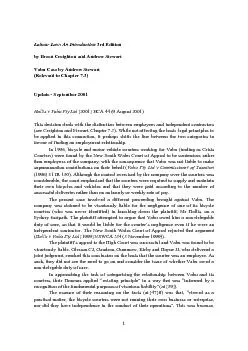/


inter alia they were ID: 824322
Download Pdf The PPT/PDF document "Labour Law: An Introduction 3rd Editionb..." is the property of its rightful owner. Permission is granted to download and print the materials on this web site for personal, non-commercial use only, and to display it on your personal computer provided you do not modify the materials and that you retain all copyright notices contained in the materials. By downloading content from our website, you accept the terms of this agreement.
Labour Law: An Introduction 3rd Editionb
Labour Law: An Introduction 3rd Editionby Breen Creighton and Andrew StewartVabu Case by Andrew Stewart(Relevant to Chapter 7.3)Update - September 2001 [2001] HCA 44 (9 August 2001)This decision deals with the distinction between employees and independent contractors(see Creighton and Stewart, Chapter 7.3). While not affecting the basic legal principles tobe applied in this connection, it perhaps shifts the line between the two categories infavour of finding an employment relationship.In 1996, bicycle and motor vehicle couriers working for Vabu (trading as CrisisCouriers) were found by the New South Wales Court of Appeal to be contractors ratherthan employees of the company, with the consequence that Vabu was not liable to makesuperannuation contributions on their behalf (Vabu Pty Ltd v Commissioner of Taxation(1996) 81 IR 150). Although the control exercised by the company over the couriers wasconsiderable, the court emphasised that the couriers were required to supply and maintaintheir own bicycles and vehicles and that they were paid according to the number ofsuccessful deliveries rather than on an hourly or weekly rate of pay.The present case involved a different proceeding brought against Vabu. Thecompany was claimed to be vicariously liable for the negligence of one of its bicyclecouriers (who was never identified) in knocking down the plaintiff, Mr Hollis, on aSydney footpath. The plaintiff attempted to argue that Vabu owed him a non-delegableduty of care, so that it would be liable for the couriers negligence even if he were anindependent contractor. The New South Wales Court of Appeal rejected that argument [1999] NSWCA 334 (5 November 1999)).The plaintiffs appeal to the High Court was successful and Vabu was found to bevicariously liable. Gleeson CJ, Gaudron, Gummow, Kirby and Hayne JJ, who delivered ajoint judgment, reached this conclusion on the basis that the courier was an employee. Assuch, they did not see the need to go on and consider the issue of whether Vabu owed anon-delegable duty of care.In approaching the task of categorising the relationship between Vabu and itscouriers, their Honours applied existing principle in a way that was informed by arecognition of the fundamental purposes of vicarious liability (at [59]).The essence of their reasoning on the facts (at [47]ff) was that, viewed as apractical matter, the bicycle couriers were not running their own business or enterprise,nor did they have independence in the conduct of their operations. This was because,inter alia, they were not providing skilled labour or labour which required specialqualifications; they had little control over the manner of performing their work; theywere presented to the public and to those using the courier service as emanations ofVabu because they had
to wear Crisis Courier uniforms; and Va
to wear Crisis Courier uniforms; and Vabu superintended theirTheir Honours also downplayed the significance of the couriers obligation tosupply their own tools and equipment. Although a more beneficent employer might haveprovided bicycles for its employees and undertaken the cost of their repairs, the fact thatthe couriers were responsible for their own equipment did not of itself indicate a contractfor services. This was all the more so because the capital outlay was relatively small andbecause bicycles are not tools that are inherently capable of use only for courier work butprovide a means of personal transport or even a means of recreation out of work time.On the face of it, this reasoning has significant implications for the manybusinesses that engage workers under arrangements that are constructed to look likecontracts for services, but which involve a high degree of dependence on the part of theworkers concerned. In particular, it indicates that provision of tools and equipment by aworker may have little significance unless the capital outlay is substantial and significantskill and training is required to operate them.Unfortunately, however, it is hard to be sure just how much to make of thedecision. On one reading of the joint judgment, the conclusion was driven by theparticular context of dealing with the issue of vicarious liability. It is not clear that theirHonours would necessarily have reached the same result in, say, a superannuation case.Indeed, they would not even say conclusively that the 1996 decision was incorrect,because most of the attention in that case focused on couriers who drove cars andmotorbikes, and it might be that the additional expense associated with such equipmentwould justify a different conclusion in their case.McHugh J, who gave a separate judgment, reached a contrary view on theemployment status of the couriers. He fastened on the significance of the fact that theHigh Court had refused special leave to appeal the 1996 decision (a point the majoritycuriously omitted to mention). To find now that the couriers were employees wouldeffectively overturn the 1996 decision. He said that extending the classical tests or theirapplication to make the couriers employees of Vabu ... would be likely to unsettle manyestablished business arrangements and have far-reaching consequences (at [69]).McHugh J went on to find that Vabu should nonetheless be held vicariously liablefor the acts of their contractors. Callinan J reached the opposite conclusion on this pointand thus dissented in the result. He did not address the question of whether the courierswere employees, since he found that the plaintiff was bound by counsels concession inthe Court of Appeal (quite proper in light of the 1996 decision) that the couriers were notemployees.